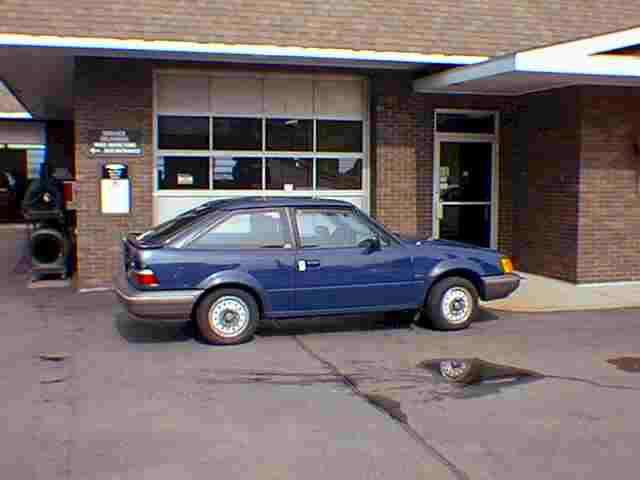
With this 90 Ford Escort, the question was, "who's fooling who?" We finally
found the fibbing component.
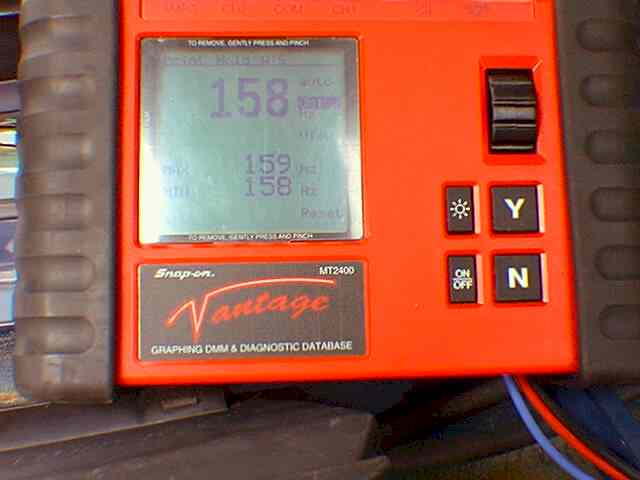
Here we see the MAP sensor displaying 158 Hz at WOT. Hmm... the MAP
is reporting full load yet the car was still running lean.
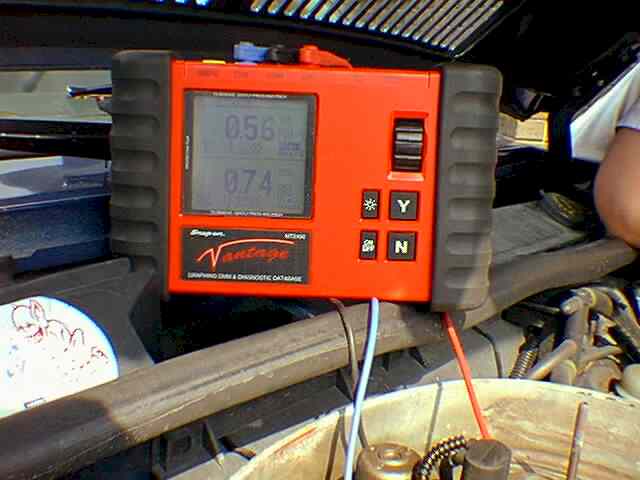
Here we are using the Snap-On Vantage to view the CTS reading over
the ACT. Using a meter with dual displays like this is a time saver as you
can verify more than one reading at a time.
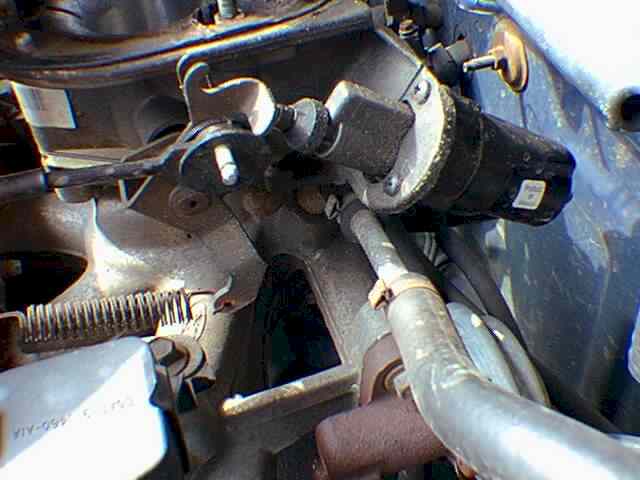
This is a side view of the idle control motor or "DC Motor" The idle tracking
switch is built into the motor and senses when the motors shaft touches
the throttle lever.
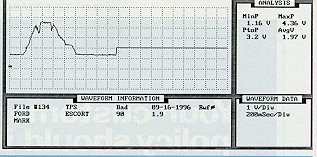
Here is what we recorded from the TPS switch on a throttle sweep.
Not exactly a healthy sensor. We believe this faulty sensor caused the PCM
to set the MAP code.
|
90 Ford Escort 3dr
1.9 Liter 5sp/MT
103,741 miles
Bucks heavily under moderate to full acceleration accompanied by a blinking
MIL lamp.
Anyone who repairs today's modern vehicles will surely agree that
automotive driveability diagnostics can be both challenging and aggravating
but usually for us technicians it's a labor of love. This time the vehicle
in the shop was a 90 Ford Escort. The vehicle is owned by one of our employees
who works at our shop as an automobile reconditioner & detailer. The employee
was complaining that suddenly the Escort would buck violently when accelerated
moderately and that during the bucking the check engine lamp would flicker
on and off.
System Overview
Our Escort's Powertrain Control Module (PCM) operates a central
fuel injector (CFI) and Fords well known Thick Film Integrated (TFI) ignition
system, to control fuel and spark delivery. A Manifold Absolute Pressure
(MAP) sensor and an Air Charge Temperature (ACT) sensor are used to monitor
engine air requirements and a Throttle Position Sensor (TPS) is used to report
throttle position. A Coolant Temperature Sensor (CTS) is used to determine
engine temperature and a heated O2 sensor is used to control fuel trim. Onboard
diagnostics is limited to a self test function that lists and stores three
types of trouble codes. Key on/engine off (KOEO) codes, key on/engine running
(KOER) codes, and continuous memory codes.
Test Drive
At first we noticed the car hunted up and down for idle speed. When discussing
this with the owner he reported that he had been driving the car with the
hunting idle problem for quite some time and that someone had told him that
a new idle control motor would correct that problem. Since the hunting idle
didn't bother him he asked us to ignore that and concentrate on the bucking
problem. A short test drive confirmed the bucking. The vehicle actually drove
quite normally if the throttle was applied slowly. However, if you applied
moderate to heave throttle, the car would buck wildly. The engine seemed to
accelerate normally when raced up, no load, with the shifter in neutral.
Testing Time
After a brief check of powertrain service bulletins we began our diagnostic
with the visual underhood inspection but it did not reveal anything unusual.
The bucking seemed consistent with what might be a lack of fuel so we road
tested the car while monitoring fuel pressure. While the car was bucking
we had good fuel pressure at 15 PSI. We connected our scan tool and pulled
the following KOEO codes:
13 DC motor not moving
38 Idle tracking switch
58 Idle tracking switch
KOER codes pulled were:
13 DC motor not moving
Owner Consultation
At this time our employee came over into the repair stall to see if we had
any new information. We advised him that the only codes listed were for the
idle control motor. That was not surprising news to him since he had been
driving the car for so long with the faulty idle motor. Once again our employee
reminded us that he did not mind the idle motor problem but really wanted
us to get to the bottom of the bucking. As Murphy's Law would dictate; "The
toughest driveability problems will occur on vehicles without datastream access."
Since this vehicle was not new enough for datastream access we decided to
hook up our lab scope to the CFI unit to monitor the PCM's pulse width command
of the injector during the bucking condition. When we applied moderate throttle
on the road test the pulse width would reduce and the car would buck. For
some reason the PCM was subtracting fuel while we were accelerating. Since
the TPS and MAP sensors are the primary fuel control inputs on this model
we decided to road test while monitoring them. On the first road test we
monitored both the TPS signal wire, (DG/LG), and the MAP signal wire, (LG/BK).
When the car was bucking we observed a good TPS signature showing correct
throttle position. The TPS value was also acceptable at idle at .96V. With
our DVOM set on Hz and connected to the MAP sensor's (LG/BK), wire we recorded
158 Hz at WOT when the car was bucking. This reading is consistent with the
0 in. of vacuum at WOT and the fact that we are geographically close to sea
level. Looks like the MAP sensor is doing its job. The MAP sensor is reporting
0 inches of vacuum or, "full load", yet the PCM is reducing injector pulse
width. Our next test found us with the Snap-On Vantage in dual voltmeter
mode while simultaneously monitoring the CTS and ACT sensor. We found .56V
on the CTS, (LG/YL), wire indicating a normal engine temperature of about
205F. On the ACT, (LG/PUR), wire we recorded 0.77V which corresponds to a
normal intake air temperature of 175F with the car sitting 10 minutes after
a hot soak. A little tip here: As soon as the car is started after a hot
soak, ACT voltage should rise as the sensor reports the colder air entering
the intake. What other fuel altering input could cause the PCM to still subtract
fuel? We decided to road test one more time with the volt meter monitoring
the 02 sensor wire, (DG/PUR). (All this work sure would have been a whole
lot easier with a datastream and a dyno, frankly we were getting tired of
driving this car). When the car bucked the 02 sensor reported lean. No surprise
there, we sure know it's lean. The question is: Why? So far we know that all
sensors are reporting correctly yet under a load the PCM cuts back fuel delivery
to the CFI unit. Must be a faulty PCM right? Time to double check our data
findings with the tec-line.
Secrets
We all know how secretive the manufactures are about computer strategy.
Ever notice that there's always someone out there in our industry that has
that little piece of "secret strategy" information that you could use? Today
it was the tec-line specialist that was telling secrets. As soon as we gave
him our sensor data and explained the "mysterious" lean command, Jerry, our
Ford Specialist at Diagnostic Hotline, was pretty sure he knew the solution.
Alas! We had been chasing a wild goose! Jerry stated that a new idle control
motor would cure our bucking problem. We really didn't believe it at first.
How can an idle control motor cause a bucking problem? We've replaced these
idle control motors before for the "hunting idle" problem but we've never
had one cause a driveability problem. For those of you who don't know,
the idle control motor used on this model is fairly common. It is simply a
reversible motor that moves an idle control shaft out to push against the
throttle lever to raise idle. When the PCM reverses the motor power and ground
the control shaft is retracted therefore reducing the idle speed. In addition,
the motor incorporates an "idle tracking switch" or " nose switch". Basically
the idle motor has an internal switch that senses when the throttle lever
is resting on the motors shaft. When the throttle is closed the throttle lever
pushes against the idle motors control shaft. Inside the motor this moves
a switch which sends about 10.5 Volts down the motors LG/W wire to the PCM.
When the PCM sees voltage here it knows the car is at idle. When the throttle
is pressed, the switch opens and the PCM sees 0V on the LG/W wire indicating
throttle not closed. Well, we know this information and still fail to see
how this relates to our problem. Listen carefully.....here comes the secret.
Jerry went on to explain that when the PCM sees voltage on the LG/W wire,
it assumes the car is at idle, and alters the fuel delivery program and goes
to "lean idle strategy mode". Basically, Jerry was telling us that
the idle switch is probably stuck in the idle position at all times. In essence
the idle switch is lying to the PCM telling it that: "were at idle...go to
lean idle strategy." The vehicle is not designed to be driven when the car
is running on the "lean idle strategy" in the first place. That's what happens
when the idle switch lies to the PCM. That explains the lean injector
command regardless of all the sensors that were reporting a load. The PCM
in effect ignores all other sensors when the idle control switch is reporting
closed throttle. We confirmed 10.5 Volts at all times on the LG/W wire as
Jerry had suspected and advised our employee that we would have to replace
his idle control motor after all.
Shame On You
It's a shame that the automotive manufacturers don't publish more information
like this regarding PCM strategy. It would make our job as technicians a
lot easier and save the motoring public time and money in that with this
"secret" information we could fix cars a whole lot quicker. There are some
cases when the technician or shop is at fault for the cost of a long diagnosis
because the information is available and they do not have the right tools
or information. However in cases of "secret strategy" like this it is the
manufactures who control the lack of release of proprietary information.
And the lack of this information can only hinder our diagnostic process,
and quite frankly, it's not the technicians fault. When asking Jerry how
he learned of the "secret strategy" he mentioned he found out about it by
heavy questioning of a Ford Service Engineer that he knew. Jerry had come
across this perplexing problem a few times when he worked at a Ford dealer
and was trying to figure out why the car's acted the way they did. Jerry
had an interesting comment about manufactures and their lack of discussing
strategy; "When I worked for the dealer the manufacturers would send
us to great training classes. They would even explain the composition of
the metal that holds the MAP sensor, but as far as strategy and how the PCM
will react to certain inputs, they just don't discuss that type of information."
Maybe some day in the future the secrets will stop. But until then, keep
your test equipment close at hand.
Back Again
About three months after this repair, the Escort was back in the
shop again. This time our employee was complaining of an intermittent hesitation
on acceleration. We were only able to duplicate the condition once. We wondered
what demons possessed this car now. The car had code 22 set KOEO indicating
MAP sensor out of range. A quick test with the DVOM on Hz showed 159 Hz KOEO
and 108 Hz at idle. A test of the MAP sensor's wave form on the Fluke 97 also
revealed a healthy sensor. Now what? On a hunch we moved the lab scope over
to the TPS signal wire. Bingo! Sometimes, during the throttle sweep, the
TPS would drop low while the throttle was actually 70% to 80% open! A new
TPS switch cured the problem. But why did the PCM have a MAP code stored?
Why not a TPS code? We theorized that when the PCM saw the faulty low TPS
signal during the actual open throttle it set the MAP code. We think the PCM
actually believed the TPS sensor over the MAP sensor. Normally when you are
applying heavy throttle the PCM sees high voltage on the TPS wire and high
Hz (low vacuum) on the MAP wire. When the TPS lied the PCM saw low TPS voltage
combined with high Hz from the MAP sensor. Evidently the PCM believed the
TPS instead and thought "the throttle is closing therefore MAP Hz should have
been lower than the reported value". At that point the PCM must have flagged
the MAP code. Evidently when this condition occurs the PCM believes the MAP
sensor is the faulty component. How's that for a tough driveability problem!
Don't always believe the code you see as gospel truth. I'll show this article
to the next person that tells me "cars must be easy to fix now, the computer
actually tells you what's wrong." If a less experienced technician had put
more faith in the computers MAP code, rather than in his own diagnostic of
the circuit, he may have replaced the MAP sensor to no avail.
Mark Giammalvo MAT, SAE, L1
Glenn Giammalvo MAT, L1
 Glenn & Mark
Glenn & Mark

|

